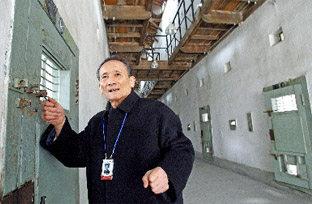Retiree gives golden years to tell Korea’s stormy past

Kim Hong-jae, a volunteer tour guide, talks about prison cells at the Seodaemun Prison History Hall. By Kim Seong-ryong
The site where he works was built in 1908 and became a notorious prison used to detain and torture independence fighters during the Japanese colonial rule of Korea. The government made the area around Seodaemun Prison at 101 Hyeonjeo-dong, Seodaemun District in central Seoul, into a park in 1992 and turned the prison into a museum in 1998.
Kim gives guided tours to Japanese tourists from 9 a.m. to 6 p.m. every Thursday. “After I saw the job posting in the JoongAng Ilbo, I applied for the position,” Kim said. “The Seoul city government taught me about Korean culture and history and dispatched me to the Seodaemun Prison History Hall.”
Though the 77-year-old volunteer has reached an age when many would prefer to rest comfortably in retirement, he is determined to go to work and explain the exact historical details of the Japanese colonial period to visitors.
“While walking in the hall with visitors, I share Korean history with them,” Kim said. “Even though other people think I should be tired of working at my age, I always feel good.”
The museum, now consisting of seven buildings, is regarded as a living monument to Korea’s ordeal during the tumultuous 35 years of Japanese rule on the Korean Peninsula. Numerous Korean independence fighters, such as Kim Koo, Ahn Chang-ho and Yu Gwan-sun, were locked up in the prison. Since the museum opened in 1998, an average of about 350,000 Japanese travelers have visited the historic site each year.
“After looking around the hall and hearing from me what happened at that time, Japanese visitors thank me for giving them the correct information,” Kim said. “Although the hall embodies the sadness of the Korean people, we have to continue to try to preserve it because of its historic significance.”
The site was originally opened on Oct. 21, 1908 under the name Gyeongseong Prison.
At that time, it consisted of 15 buildings which could hold a total of 500 inmates. The Seoul city government named the remaining seven buildings Seodaemun History Prison Hall in 1998.
Three prison buildings and the execution building were designated National Historic Site No. 324 in 1988.
By Joo Jung-wan JoongAng Ilbo [enational@joongang.co.kr]










with the Korea JoongAng Daily
To write comments, please log in to one of the accounts.
Standards Board Policy (0/250자)